Anthony Metivier's Blog, page 27
January 2, 2019
The Wise Advocate: Become A Better Leader Of Your Memory
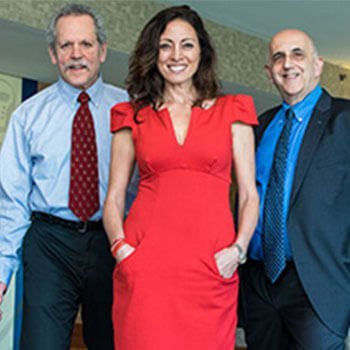 The Wise Advocate wants to help you avoid the terrible habits that keep you locked into habitual thinking…
The Wise Advocate wants to help you avoid the terrible habits that keep you locked into habitual thinking…
Thinking that is deeply connected to your memory.
Yet, after reading a new book on the topic, I was puzzled…
Why in the 21st century are we sophisticated humans still being yanked around by our lizard brain?
Especially in the midst of so much knowledge about how the brain and memory works?
I’m talking about impulsive thoughts, terrible decision making and paying too much attention to horrible mental content that arises in memory.
To find out, I asked co-authors of The Wise Advocate: The Inner Voice of Strategic Leadership to explain.
In this incredible new book, Jeffrey Schwartz, Josie Thompson and Art Kleiner provide simple ways to overcome impulsive thinking and create greater leadership in your life and for others.
About the Authors of The Wise Advocate
Jeffrey Schwartz is a research psychiatrist at UCLA and a leader expert in neuroplasticity. He is the author of You Are Not Your Brain and books on overcoming obsessive-compulsive disorder amongst other topics.
Josie Thomson is an award-winning executive coach, speaker, author, and two-time cancer survivor.
Art Kleiner is the Editor-in-Chief of strategy+business and author of The Age of Heretics and Who Really Matters: The Core Group Theory of Power, Privilege and Success.
Show Notes And Stand Out Topics
Since my passion for memory can get the best of me in matters of business, I was very interested in the discussion of creating more distance and rationality in decision making.
Plus, I learned a lot from the discussion on group think, or tribe mentality, and how to overcome some of the knee-jerk reaction to appease others we see happening more and more on the Internet.
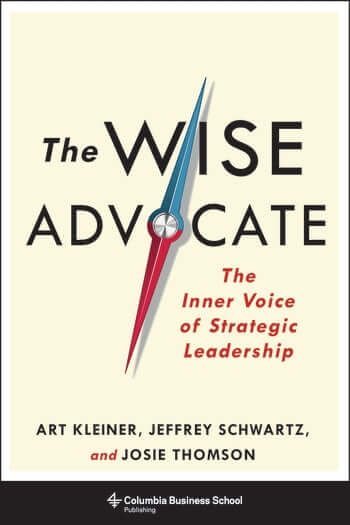
As a solution, Jeffrey suggested a kind of self-inquiry in place of visceral reactions:
“You become more aware of who you’re trying to please, why you’re trying to please that group, that person. [Thinking instead] ‘What are the implications of what you’re doing?’ You start planning and thinking more long-term.”
Finding Your Wise Advocate Is A Trainable Skill
When we train ourselves to contemplate questions like, “Why do they (others) want that?” we open ourselves up to being an impartial spectator of the world.
This impartiality leads us into a higher level of thinking to overcome this “lizard brain.”
If you want to know how your decision making can drastically improve with a shift in focus, or a directed, conscious effort to revamp your mindset in order to be a better leader, or even just lifelong learner, this podcast is for you.
You will unlock the secrets to active mindfulness through simple practice and awareness to be a quality, individualistic, strategic decision maker.
All you need to do is press play above and you’ll learn:
What exactly mindfulness is and how it can help you clarify your own goals, objectives, and ways of approaching everything in life
How to be transparent in your own thinking to achieve your long-term goals and plans
How memory can set you free with decision parameters that you make every day
The inner narrative of “gut impulses” versus the big picture of decision making
Identifying the difference between emotional reasoning and rationalizing
How obsessive-compulsive disorder relates to brain structure and value judgements
Understanding how you arrive at decisions gives you wiser choice options
The idea that habits are largely unconscious
The concept of mentalizing (not “What do others want?” but “What are they thinking and why?”)
How the desire for “fitting in” influences our decision making
How community-oriented perspectives achieve win-wins in business relationships
Rewiring the brain to a “wise advocate” frame of mind to inform decision making (for students who want to know how to study fast, this one will be key)
Applying the understanding of human behavior to goal-oriented activities
Deceptive brain messaging in the role of executive thinking
Self-directed neuroplasticity as an influencer of thought and attention of focus
Balancing non-judgmental thinking with assessment in your thought processes
How memory practice and working memory is important in taming impulsive behavior
The four steps to correct the cognitive distortions you might be making every single day
Although The Wise Advocate is directed at people in leadership roles, I highly recommend this book to all memory improvement fans.
After all, you are the leader of your memory. It needs you to be performing at your best!
Further Resources on the Web, This Podcast, and the MMM Blog:
Homepage of Jeffrey M. Schwartz, M.D.
Further Reading from Art Kleiner
Order The Wise Advocate from Amazon
More About Habits (How to Hack Habits with Joanna Jast)
Goal-Setting with Memory Palaces
The post The Wise Advocate: Become A Better Leader Of Your Memory appeared first on Magnetic Memory Method - How to Memorize With A Memory Palace.
December 27, 2018
7 Powerful Mind Mapping Examples For Better Method of Loci Success
 We all know about mind mapping and the Method of Loci as independent learning and memory tools, but …
We all know about mind mapping and the Method of Loci as independent learning and memory tools, but …
How many people use the mind mapping technique to help them use the Method of Loci better?
The answer is simple:
Not as many people as I would like!
Worse, some people struggle unnecessarily with how to find Memory Palaces.
They know they need many of them in order to get the Method of Loci operating properly, but they struggle to find enough of them.
Let’s put an end to this struggle right now.
On this page you’ll discover how they can work together to help you create dozens, if not hundreds of Memory Palaces by creating a simple Mind Map.
How To Get Started With Mind Mapping For Finding More Memory Palaces
If you’re anything like me, there’s only one frustration that comes with learning a new skill.
You want things to be perfect… instantly!
Seriously – who doesn’t?
Well, let me caution you that using mind mapping to help you benefit from the Method of Loci is NOT for perfectionists.
Be willing to drop your perfectionism and progress towards consistently becoming better.
Bring your flexibility, your willingness to “just do it,” and joyously make mistakes for the purpose of growth.
Mind mapping is not a final destination, a journey from point A to point B.
The Biological Secret Behind These Mind Mapping Examples
Instead, it is like a brain cell on paper, with multiple tributaries that radiate outwards from a central point.
It’s kind of like how rivers flow from lakes out into the oceans.
In other words, mind mapping is organic.
And the process is not a linear race to some end point. Rather, it is a process and a journey – not unlike the “journey method” of the method of loci itself.
Except, in this case, we’re “unlocking” as many journeys as we can assisted by mind mapping.
Understanding this concept is the first step to success. Then understand the process.
Why is this point so important?
Because as a lifelong learner, you will always be stepping into an unknown future.
But if you have a hyped-up destination in mind based on bankrupt ideas about how your brain works, you’re just begging for frustration.
Indeed, you’ll be paralyzed by inaction before you can even begin.
So just relax.
Take a deep breath. Put pen to paper.
The First Step In Mind Mapping For Generating Memory Palace Ideas
The starting point to creating an effective mind map, as taught by Tony Buzan in Mind Map Mastery is to have a large central image that uses at least three colors.
This central image should be inviting, one you’ll want to revisit.
You don’t have to be a great artist.
Once again, don’t overthink it!
Let your mind wander as you draw, but wander in a focused way.
The First Mind Mapping Example:
The Parthenon
To mind map the Method of Loci, for example, our central image could be a Parthenon-esque column to represent the origin of this incredible mnemonic device.

I chose the Parthenon due to an association with Simonides of Ceos and stories that link the origin of the Memory Palace with ancient Greece.
But you might choose something else, perhaps from even earlier in history based on Lynne Kelly’s discoveries about this technique in The Memory Code.
A Simple Process That Unlocks the Power Of The Method Of Loci
From that central image, we travel outward by creating a radiating tributary.
Then use a simple process of asking yourself questions. For example, ask:
Where do you spend a majority of your time?
What surroundings are most familiar?
What environment is the most recognizable?
For most people, the answer is home.

How To Use Mind Mapping To Find Multiple Homes For Memory Palaces
Whether you list your childhood home, college dormitory, a beloved first apartment, or your current residence, “home” is a place that you know frontwards and backwards, inside and out.
List every “home” that comes to mind.
This choice already opens up so many possibilities for multiple Memory Palaces, doesn’t it?
Thank the Mind Map process. And this:
Why Mind Mapping Helps You Start Finding More Memory Palaces
Don’t worry. This is just the beginning of the ideas I’ll share on this page.
But it will help you even further if you understand why this process is so valuable to your progress.
Think of your brain as a garden.
You have this rich soil (your brain cells).
Let’s say that about 10-20% of that soil is involved in your spatial mapping and spatial memory abilities.
Well, without “excavating” more Memory Palaces from the soil of your mind, you’ll never have enough rows to plant seeds of memory using association-based mnemonics.
But when you get this right, you’ll have multiple perfectly tended rows to load full of seeds that will eventually create an incredible harvest every time you wish to remember new information.
More Incredible Mind Mapping Examples For New Memory Palaces
Consider the remaining blank space on the page with your mind map.
What other homes are you familiar with?
Friends’ homes?
Extended family?
Amazing “Virtual” Memory Palace Ideas You Can Experiment With
What about homes of fictional characters?
Aren’t we all familiar with Monica’s iconic apartment on Friends?
What about the Addams’ mansion, or the lush greenery of The Shire, home of Frodo Baggins and Samwise Gamgee from Lord of the Rings?
Relax, extend, and cultivate to expand your mind map.
Then think about schools, movie theaters, video rental outlets and even think about how to increase memory by watching movies and TV series.

The possibilities are endless for exploration.
Once you realize this fact, mind mapping lends itself to a natural flow.
The only warning I have is that you might need additional training so you know how to enhance your memory with Virtual Memory Palaces properly.
Branching Out Further For More Method Of Loci Tools
Once that flow has been created, get out of your own way.
You may associate home with your childhood home, then, in turn, your childhood years in general, which naturally leads to reminiscing about “school days.”
Given about seven hours a day, Monday through Friday, for over a decade were spent in school, this is another familiar place that can lend itself to a branch on your mind map.
Then there are churches, libraries, movie theaters. These are all big, grand, familiar places from which we can expand our web.
All of these places have specific areas inside of them, details that you can, and should, allow your mind to explore, and revisit.
Then use a central image and let the ideas flow.
How Mind Mapping Helps You Creatively Follow Chains Of Association
As you relax into the process, the combination of keywords and images will trigger memories.
For example, in your elementary school there was likely a playground, gymnasium, library, and cafeteria.
Thinking of your library may lend itself to thinking of your favorite books, then favorite authors, or favorite movies that were adaptations of those books.
Exploring the idea of your cafeteria may lead you down a path of your favorite lunch day, or a memory of your Batman lunchbox.
Where does that notion of the Batman lunchbox lead? Perhaps back to the early television series with Adam West, then back to a notable “home,” the Bat Cave.
How To Uncover Amazing Car Memory Palaces
You can also use cars. I have four that I use – the same four that I drove during high school and early university.

It’s pretty simple:
Just reflect back through all the cars you’ve owned.
You could also add cars your family members and friends have owned and potentially cars from movies that stand out in your imagination.
Use these places, these ideas that seemingly come at random and record them onto a mind map, taking note of how they weave together.
It’s just part of how to study fast. Fun, isn’t it?
How Mind Mapping Can Unlock Dozens Of Churches For The Method Of Loci
For example, I drew a simple cross to represent the idea of a “church.” This instantly led me to think of churches I’d been to as a kid and that I’d visited while living in Europe.
As luck would have it, the Kaiser Wilhem Memorial Church in Berlin (Gedächniskirche) leapt to mind. It’s a powerful Memory Palace!

With more practice, you’ll see that these ideas aren’t random at all. The mind mapping technique is helping you make better associations that lead to more familiar and powerful Memory Palace options.
Mind Map Your Body, Furniture, Musical Instruments & More
Yes, you can use your body as a Memory Palace.
Your guitar, your sofa, anything goes.

The important thing is that you:
Get out a large piece of paper.
Create a central image that represents the goal: Identifying multiple Memory Palaces for developing your method of loci skills.
Understand that the tributaries “radiate” outwards.
Allow these tributaries to radiate further (i.e. from “home” to the homes of your friends, family and even fictional characters.
Use both keywords and simple drawings.
Relax before you get started.
Focus on progress, not perfectionism.
Draw each Memory Palace you identify.
Use the Memory Palaces as soon as possible.
Come back to mind mapping to find more Memory Palaces and get more out of the method of loci technique.
Summing up, the ideas I came up with this process were:
Homes:
All the homes I’ve lived in
The homes of all my relatives
Homes of all my friends
Homes represented in movies and TV series
Movie related areas:
Movie theaters I love
Old movie rental outlets (remember those?)
Film sets I’ve visited
Churches
From when I was a kid
From years of travel
Cars
Cars I’ve owned
Cars of family members
Cars of friends
Body Memory Palace ideas
My own body
Bodies of friends
Bodies of actors
Bodies of fictional characters
Furniture for small Memory Palaces
Musical instruments for use with music mnemonics
In sum, this amounts to seven categories and dozens of potential Memory Palaces.
The Mind Map Template That Never Ends
There is more stored in your mind than you might realize. Use mind mapping to tap into it.
It’s all there. Waiting to be retrieved. Waiting to be used.
Your brain really is the mind map template you’re looking for. You just need to exercise this powerful memory technique so you can use all other memory methods better.
Let mind mapping help you bravely tap into your creativity and revitalize your memory.
But your journey doesn’t stop there!
Just the opposite in fact.
This is truly just beginning…
To fully utilize these Memory Palaces mind mapping has helped you identify, use them a.s.a.p to store the information that’s important to you.
Need more? Check out these 5 Memory Palace Examples To Improve Your Memory Training Practice.
Enjoy the process as a practice to use again and again for life!
BONUS! Mind Mapping Examples Unpacked Live
This blog post was originally created on a live stream with help from the Magnetic Memory Method Audience.
Feel free to watch the replay while you’re here:
The post 7 Powerful Mind Mapping Examples For Better Method of Loci Success appeared first on Magnetic Memory Method - How to Memorize With A Memory Palace.
December 20, 2018
How to Memorize Vocabulary: A Step-By-Step Guide
 You’d love to know how to memorize vocabulary at epic speeds, right?
You’d love to know how to memorize vocabulary at epic speeds, right?
Whether it’s for improving your mother tongue or learning a new language, the desire to expand your vocabulary is natural.
In fact, if you don’t want to get better with language, you really need to sit down and think about why you aren’t devoted to lifelong learning.
Knowledge truly is power, after all, especially when you apply it to speaking.
People who speak well perform better at all aspects in life, love and professionalism.
A Brief History Of How I Fell In Love With Memorizing Vocabulary
During both high school and university, I loved looking through my thesaurus.
I would regularly “beef up” my term papers with “five” and “ten dollar words” to make my writing more interesting and to teach myself more words.
For example, I learned the word “solipsism” when researching and writing a 3rd year university paper in “Shakespeare and his Contemporaries,” taught by Dr. Derek Cohen.
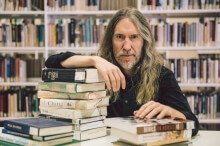
He noticed that I used this word when grading the paper and this encouraged me to explore interesting vocabulary even more.
Soon I was talking about “architectonic tautology,” “paratexts” and whipping out all kinds of ancient Greek and Latin terms in my writing.
And never for the sake of my ego.
It was for the love of language and the knowledge that using words well brings.
These days, you can access an online dictionary and thesaurus in ways that are a lot simpler than thumbing through a well-worn set of word collections on your desk.
But no matter how you access your words, you really can make vocabulary acquisition effortless and limitless.
Why Rote Learning Any Word Is Painfully Slow
Back then, I used rote learning to memorize those words.
It was painful!
Why is rote learning so annoying?

For one thing, it’s repetitive and boring.
It’s also not fun.
And research typically shows that you get only about a 40% rate of recall.
With mnemonics, on the other hand, anyone can boost that rate of recall to 80%.
And when you practice with memory techniques regularly, that rate will rise even higher. Here’s how to practice memory techniques for studying anything, including improving your language abilities.
I’m so glad I learned about memory techniques like the Memory Palace during my Ph.D. years.
This special strategy taught me how to memorize oodles of difficult vocabulary quickly.
So what if I told you that you could become an absolute Titan of word power in a way that is fast, easy and fun?
Well, you can. And you have this ability within yourself right now.
You have all the tools you could ever need to drastically expand your vocabulary, by improving your ability to memorize words.
Basic Rules That Let You Memorize Vocabulary Forever
Let’s begin with a bird’s eye view of vocabulary memorization.
Let’s face it:
You may be overwhelmed at the beginning with questions about where to start.
This feeling is normal.
After all, there are well over a million words in the English language alone.
How could you even make a dent in this number, never mind if you are learning a second or third language? Let me break it down in simple terms.
1. Your goal is to memorize the sound and the meaning of a word.
2. You do this by having a Memory Palace Network prepared in advance.
3. When you know how to navigate the Memory Palace Network well, you “encode” each word using Magnetic Mnemonic Imagery.
4. You use Recall Rehearsal to get the words into long term memory.
5. You use the Big 5 of Learning to speed up the process and ensure longevity.
If you have any doubts about putting these steps into action, please remember that bilingualism makes for a healthier brain. You owe it to your long term health.
The Amazing Truth About How To Memorize Word Meanings
Now, when I talk about memorizing the sound and meaning of a word at the same time, this doesn’t mean EVERY meaning of a word.
We’re talking about one, or at most two, meanings of any given word when we start.

Seriously:
Be willing to let the 430 other possible definitions and usages listed in the Oxford Dictionary go.
The same thing goes for German or any other language.
Speaking of German, here’s The Story Of How To Learn and Memorize German Vocabulary It’s about my very first book on memorizing vocabulary and includes more mnemonic examples to help you memorize vocabulary forever.
You Do Not Have To Commit Every Meaning To Memory To Learn A Word
Again, just because multiple definitions exist, this fact does not mean you should commit them all to memory.
You need only to memorize the one, or very few, meanings relevant to you.
You do this by thinking about the Magnetic Station in your Memory Palace.
Then you create Magnetic Images that remind you of the sound and one core meaning of the word.
Then, take a deep breath.
Relax.

Come back and do Recall Rehearsal later and encode a few more words.
Or you can come back and add an entire phrase to the word.
Often less is more. Keep that principle in mind.
The Powerful Rule Of Difference In Vocabulary Memorization
Each word is different.
Words have varying syllables, different origins, and are fluid in certain grammatical contexts.
Words might also be changeable when you add prefixes and suffixes.
Don’t turn these changes into the enemy!
Just treat these changes like the beautiful differences in a diverse experience of language that they represent.
And then memorize them as individual examples like you would any other word.
If you want to scale the process, you can sometimes create a Memory Palace series just for regular and irregular verbs.
If you’re still unclear about what this technique involves, here are 5 Memory Palace examples. Even better, try this:
But only use Memory Palaces if you find them helpful.
Whatever you do, don’t generalize the process too much.
There is no “one-size-fits-all” magic bullet that will work with every single word when it comes to memory techniques for language learning.

Words do not all behave the same, and we cannot treat them as if they do.
Once we understand that we must work with vocabulary individually we are ready to hit the ground running.
The Magic Of Word Grouping for Memorization
Do you remember learning to count syllables as a kid?
Perhaps your elementary school teacher taught you to clap with each syllable as you said words out loud.
Maybe he taught to you hold your hand under your chin and count every time your jaw would “drop” when you said the word aloud as a syllable.
I have a friend who remembers practicing se-ven, el-e-phant, yel-low, and rock-et as a young child. She made a game of it.
She found it exciting!
And it is exciting. You can take a little bit of that wonder, that excitement, and put it into practice with vocabulary memorization techniques.
How?
Group words with the same number of syllables together.
Arranging words in a like with like form based on syllable is a powerful tool to help with memorization.
You can also experiment with arranging words by vowels.
Another professor I learned a lot from named Christian Bök spent a long time arranging words by vowel for his excellent book, Eunoia. Here’s a sample:
Do you notice what he’s doing here?
All of the words in this passage feature only one vowel. “I.”
Although you might not do exactly this in your own Memory Palace Network, I’m sure reading more of Bök’s works will inspire you to think up many games you can play with language learning.
Sure, organizing words takes a bit of initial legwork.
The Horrible Price Language Learners Pay When They Fail To Plan
But what happens when you don’t craft a vocabulary list and arrange it for strategic memorization?
Random chaos!
But when you tackle it strategically for use in Memory Palaces, you will have a simple key to success with memorization.
Why Practice Makes Progress Better Than Any Memorize Vocabulary App
Once you have your target vocabulary organized and know what you need to commit to memory, you are free to practice using memory techniques for language learning.
You can now focus solely on the task of expanding your vocabulary.
It really is that simple.
How do you improve your abilities with memorizing vocabulary with consistent growth over time?
Simple:
You memorize vocabulary.
Commit to practicing a word list every single day.
The Freedom Journal used for language learning will help because I’ve shown you how to combine it with a Memory Palace technique.
Gradually you will notice improvement – if not very quickly.
Chart this improvement in your Memory Journal. You will soon see how far you’ve come.
The Power Of Context For Memorizing More Words Quickly
Then, use your memorized words in context.
Just as with any other memory technique, the key is immersion.
Use your vocabulary when reading, writing, speaking, and listening.
Use The Big Five techniques to your advantage.
How To Choose The Words You Memorize Wisely
Another rule of context that is so simple, yet profound is to choose the words you memorize carefully.
Just as we discussed the bird’s eye view of memorizing relevant definitions, the actual words you seek to memorize should only be ones that will improve your life.
If the list of words is not improving your life and moving you towards your goals, then the words really have no business being memorized.
There are many sources of word lists, but Ogden’s Basic English is a great and free source for figuring out what words you might want to learn in any language.
You just need to make sure you have goals – meaningful goals.

What are some goals you might have for memorizing vocabulary?
* Learning a foreign language
* Studying Medicine
* Preparing to pass a law exam
All of these goals add meaning to your efforts, which is essential to the formulation of a life long skill that becomes habitual.
A Review Of The Fundamentals With A Few Mnemonic Examples
Why does meaning matter so much when memorizing vocabulary?
To really commit words to memory they must be more than just words.
In addition to having a reason for memorizing them, meaning will help you come up with associations, especially when the going gets tough.
For example, there are a lot of Sanskrit words I’ve been memorizing and it’s only because I have a meaningful goal driving my project that I’ve been able to push through.
In addition to the mnemonic examples in that video, recent research further validates the notion that the signing and chanting element also play a role in memory formation.
Of course, we usually aren’t singing the vocabulary we learn. Definitely do that in the shower if you’re worried that people won’t like your voice!
And with singing on your side, here are some every day words in English that are quite challenging.
All you have to do in addition to having a Memory Palace ready is to associate each word with images.
And think about how these examples apply to the words you want to learn and memorize.
“Account” Mnemonic Example With Magnetic Action
Think of the word “account.”
If you’re like me you grew up with Big Bird, Oscar the Grouch, and a host of other characters on the children’s show Sesame Street.
Who taught you numbers? Count von Count, right?
He’s the one who taught me, and because he is deep in my brain’s chemistry, he’s the perfect “sound-match” for “count” in “account.”
But we have an additional “AC” to add to that word.
For that, think of an air conditioner falling out of a window onto the Count.
To get the meaning into the image, this air conditioner also looks a fair amount like a calculator – the tool used by an accountant while engaged in the act of accounting.
This action and object-based visualization with a meaningful character from pop culture almost guarantees you’ll not forget that word.
Why?
Because movement catches the “mind’s eye.”
Even if you have “aphantasia,” you will likely find this imagery shocking to you.
The only “trick” is that the images and actions are meaningful to you.
The next example will demonstrate this principle a bit further.
“Agreement” Mnemonic Example with Personal Magnetic Imagery
As with the Count in “account,” the word “agreement” needs some tender loving care.
Since I took Agriculture 11 in high school where we learned to farm and about different cuts of meat, I can visualize my teacher of that class, Mrs. Sanderson.
Although I never saw here getting greedy with mints or cackling like the Wicked Witch of the West at her desk, it’s useful to think of her that way.
Why?
Because she taught Agriculture and her being greedy over her drawer full of the red and white disc peppermints helps create the sound “agreement.”

Next, all I have to do is see, feel and hear myself agreeing with her greed so that I’m in agreement with her actions.
This visualization easily helps me commit the word agreement to memory as I paint this picture in my mind.
The Truth About Mnemonic Examples For Learning And Remembering Vocabulary
Mnemonic examples like these can only get you so far.
You need to understand and then practice the mnemonic principles that underly the memorization techniques.
Take what is relevant to you from these examples and apply the techniques to the words that will help you achieve meaningful goals.
Create engaging mental pictures that come to life in your mind as you break the words down into parts.
You can also create stories from the actions you create if that helps you.
Here’s the best part:
Because you have taken the time to play with these words and interacted with them you will naturally start to remember them.
It’s so simple once you break it down, word by word, piece by piece.
Why Memorizing Vocabulary Is The Most Important Skill In The World
Memorizing vocabulary is not only the easiest skill, but it’s also the most important skill you’ll ever have.
Almost all of the most important information we use to survive is transmitted through words. They are the building blocks of all language and information.
Vocabulary is crucial and essential to improvement in all areas of life. In short, words are fundamental to success as a lifelong learner.
To grow you must have a solid foundation.
So let me know:
What vocabulary are you going to memorize now that you know these memorization secrets?
The post How to Memorize Vocabulary: A Step-By-Step Guide appeared first on Magnetic Memory Method - How to Memorize With A Memory Palace.
December 12, 2018
How to Study Fast: A Guide To High Volume Learning At Speed
 If you’re serious about learning how to study fast, get ready to say goodbye to those horrible emotions of anxiety and fear.
If you’re serious about learning how to study fast, get ready to say goodbye to those horrible emotions of anxiety and fear.
That’s right.
Instead of wringing your hands in terror every time you’re facing an exam or professional certification…
You can simply sit back and congratulate yourself on a job well done.
How can you trust me?
Great question. Here’s the answer:
I’ve got a Ph.D., two Masters, a BA and several certifications.
And I’m here to tell you that you really can study quickly and effectively without all the stress others go through.
Let’s get started.
How To Plan For Speed Studying Using Effective Scheduling
First things first, please understand this:
You should always schedule a planning session for how you’re going to get enough studying done.
Now I know you may be thinking that this seems contradictory. After all, you want to study quickly, and planning feels like it takes more time than it’s worth.
But think of it like this.
You’re throwing a backyard barbecue for your friends and family. It’s late summer and still quite hot outside.
What’s the number one thing your guests will need?
A cold drink!
You wouldn’t be prepared for the party if you just relied on your three measly ice trays in the freezer to chill everyone’s drinks would you?
Certainly not!

You’d stock up on bagged ice from the store along with all your other BBQ essentials. You could only be prepared for your guests if you planned ahead.
The same goes for your study sessions.
Just like making a list of all your barbecue supplies saved time and stress of filling up all those ice cube trays last minute, having a plan in place for studying is a real time saver.
How To Craft Your Studying “Plan Of Attack”
Planning can be as simple as writing down your plan of attack on paper.
Like this:
“I will commit X number of hours,” (or even minutes) “per day to studying.”
If you’re attending university and you have a syllabus, refer to that to plan your study sessions. It will tell you WHAT you need to study, then use your calendar to plan WHEN you will study, and even where you will study.
Why You Must Plan Your Study Breaks
It’s also important to plan for breaks.
Giving your mind a reprieve is essential for effective studying.
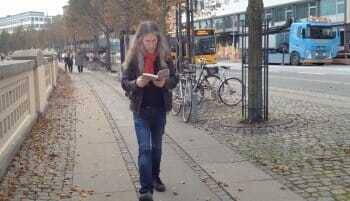
When I was in university I would study in the library, usually near a section that was music related.
This way, after I had studied for my predetermined amount of time, I could read about a topic I was generally interested in.
Or I would take a walk and read.
Unusual, I know, but it’s actually very relaxing and helps you keep learning while getting a break at the same time.
Plan For Unexpected Interruptions To Your Studies
We must remember though that life happens.
If we have a perfect plan in place for our study sessions then an emergency comes up, what then?
What if there is an illness in the family or a professor strike at university?
Because such things do happen, we must be flexible and revisit our plan.
Plan, and plan again, because life truly is unpredictable.
Finally, as you create and revise your plan make sure to schedule time for creating Memory Palaces.
Why?
Because a solid Memory Palace strategy is, without a doubt, the most effective way to study efficiently.
This fact is true because this memory technique unlocks your spatial memory and spatial mapping.
Just ask my friend and fellow memory expert Nelson Dellis.
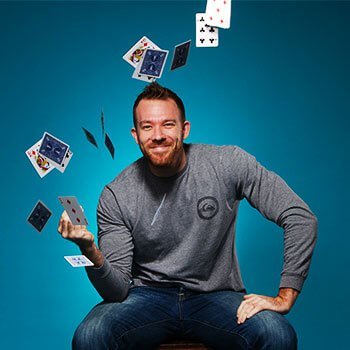
The more you create and use Memory Palaces, the more they unlock multiple levels and layers of memory that you can use in order to learn faster.Which levels of memory exactly?
These ones:
Autobiographical memory
Episodic memory
Semantic memory
Procedural Memory
Figurative memory
And more… all unlocked through a Memory Palace devoted to improving your memory for studying to make your study sessions faster and more powerful.
In sum:
Benjamin Franklin famously said “If you fail to plan, you plan to fail.”
Nothing could serve as a better, literal reminder for you to schedule those study sessions along with breaks and ideas for what you’ll do when things suddenly change gears.
Final Exam Study Tips That Will Simplify Your Life
The most important tip I can give you in terms of simplifying your learning life is this:
“Don’t cram.”
Seriously.
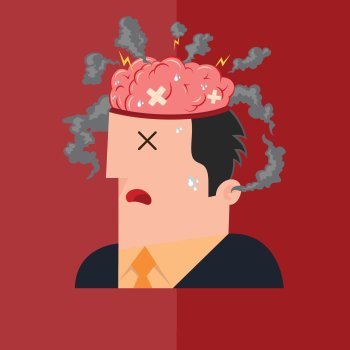
Cramming makes you feel overwhelmed, frustrated, and keeps you asking questions you cannot answer under pressure.
I’m thinking of questions like:
“Where do I start? How do I do this?” and “Where do I even begin?”
Now, overwhelm and frustration is totally normal.
But the kind of frustration that comes from cramming- it’s totally avoidable!
The Best Study Shortcuts Provided By The Big Five Of Learning
Aside from the obvious “Don’t cram,” I highly encourage you to truly understand the “Big Five” of learning, which are:
Reading
Writing
Speaking about the topic
Listening to others
Doing all of this from memory to help you remember everything better.
And you want to put the Big Five of Learning into action as frequently as possible.
This process will help you truly process and retain what you’ve read and make deep connections in your brain.
Here are some suggestions as to how you can make the Big Five easy and fun:
Listen to podcasts on the topic, or even a loosely related topic.
Write summaries of what you’ve read.
Join a study group (either online or offline – ideally both) to discuss the information you need to know. Discussion helps especially if you’re stumped on grasping a certain concept, or have a mental block about a subject.
All of these approaches help you gain a fresh perspective, especially if student with those in different disciplines that compliment yours).
When Push Comes To Shove: How to Study in One Night
But what if the unthinkable happens and the night before the exam you’re faced with the prospect of having to pull an all-nighter?
In the immortal words of Douglas Adams’ The Hitchhiker’s Guide to The Galaxy, “Don’t Panic.”
First, break the study material down.
For example, if you had an exam solely based on one book and you procrastinated all semester and didn’t do the assigned reading.
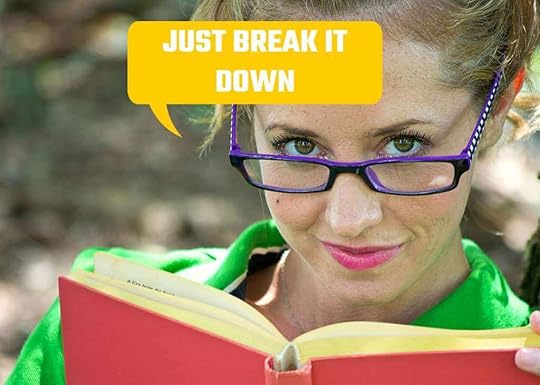
Ask yourself “Okay, so how many chapters does this book have?”
Then ask, “How many pieces of information am I actually likely to remember tomorrow?”
Break this down further and say “There are 10 chapters in the book. The maximum I can memorize is three things per chapter,” then read for those three big ideas in each chapter.
For more on this technique, please see, How to Memorize A Textbook.
Use The Major Method (Or Major System) To Help Rapidly Remember Numbers
You can also use a memory technique called the Major Method.
This technique will help you remember where those pieces of “need to know” information are located in the book as you read because it helps you memorize the page numbers.
This helps you easily go back to those pages and commit them to memory.
Here’s where the Memory Palace, again, is key.
A Memory Palace lets you commit a room or station to each of these pieces of information.
Can’t Keep Up? Find Syllabi And Example Exams From The Past
Secondly, find example exams if you can from past semesters.
If your school won’t provide them, contact other schools. In the Internet age where virtually everything is available online, use that limitless database to your advantage.
Can’t find example exams on your own?
Network. Consult with others even at the last minute.
If you can work together to capture the big ideas, the “need to know information,” this will go a long way if you find yourself cramming the night before an exam.
The Most Effective Study Techniques For World Class Learning At Speed
Many students’ number one go-to strategy for studying is re-reading assignments and notes.
This learning technique, however, is simply not as effective as we believe.
Mark McDaniel, a Washington University psychologist said:
“On your first reading of something, you extract a lot of understanding. But when you do the second reading, you read with a sense of ‘I know this, I know this.’ So basically you’re not processing it deeply, or picking more out of it. Often, the re-reading is cursory – and it’s insidious, because this gives you the illusion that you know the material very well, when in fact there are gaps.”
Instead of the somewhat flawed, yet popular, re-reading, I suggest pre-reading instead.

What is pre-reading?
It’s simply this:
“The process of skimming a text to locate key ideas before carefully reading a text (or a chapter of a text) from start to finish.
Prereading is essentially an overview that “can increase reading speed and efficiency. [It] typically involves looking at (and thinking about) titles, chapter introductions, summaries, heading, subheadings, study questions, and conclusions.”
Another technique for active learning and effective studying is Magnetic note taking.
I’m not talking about the boring rote note taking that you’re likely used to.
I’m not suggesting you copy information down on an index card.
Instead, you need to be engaged, present in the moment and taking creative notes.
I detail everything about this in the Magnetic Memory Method Podcast here.
You can also use this style of note taking to create your Memory Palace networks. Add mind mapping for best results.
The Speed Learning And Memory Magic Of Acronyms
Use acronyms. We’re all familiar with them, especially in the digital age. ASAP, MIA, BTW, LOL, FYI – the list could go on.
Take a look at those acronyms again.
I’ll bet that you could identify all of those shorthand phrases with ease, and for good reason:
These are powerful memory tools that can help you instantly recall information.
Do you remember PEMDAS? Many learn this acronym in school for parenthesis, exponents, multiplication, division, addition, subtraction.
Why does this information stick with people for 20 years or more? It’s because the simple, if odd word that the acronym creates makes the information more engaging and real to the mind.
More Memorization Tricks That Make You An A+ Learner
(At Any Age)
Email yourself. Remember those summaries I suggested writing? Take a few seconds and email them to yourself. You can read back over them with fresh eyes.
Just the act of doing more with the information is helpful. That small, extra step can work to your benefit.
Next, find and visit the examination room. This can be very helpful, not only to remove the pre-exam jitters, but to turn the room itself into a memory palace.
And now for the elephant in the room, the distraction of the Internet. Be cautious of the time you spend on Facebook.
Although Messenger can be great for communicating with the study groups you formed and Facebook groups can help you organize those study sessions, you can lose focus with the temptation to constantly scroll through your newsfeed.
Block those apps that cause distraction during your study sessions (I use Kill News Feed).
Remember: Digital Amnesia is real.
Your concentration can be interrupted merely by the thought of those apps. If possible, go offline for your study.
Read from physical books instead of digital screens.
Remove the physical temptation for “just a quick check-in.”
Technology doesn’t have to be a distraction.
If you’re going to go online, why not have your notifications filled with useful information? A handy tool for this is Google Alerts. Use that study preparation time to subscribe to alerts relevant to your material.
You’ll receive emails at your chosen frequency about new books, blog posts, news articles, and podcasts that can further help you incorporate the Big Five into your studies.
Reinforce the information you need to know by any avenue you can.
Concentration Tips For Learners That Eliminate Brain Fog
Meditation is by far the biggest lever.
If you are in a high stress state of mind, your concentration will be shot.
A simple walking meditation can “take the edge off” so you can make the most of your time.

If you want to go deeper into meditation I recommend Happiness Beyond Thought: A Practical Guide to Awakening by Gary Weber. He’s my go-to teacher for everything related to meditation that helps you learn more faster.
Become a Master of Real Speed Learning By Playing The Long Game
All these techniques and additional tips are geared towards helping you learn more, faster.
But to be a true master of speed learning, you’ve got to play the long game. Yes, even if you’re dealing with boring topics.
Remember the tortoise and the hare? Who ended up being the winner of the race?
Be the tortoise who wins the race. Be in this for life.
Don’t think about the short-term exam. Think about how that this is all going to wrap up to your future.
Set your goals, both long and short term.
Use those all-important planning sessions to put a plan in place to reach those goals. Then don’t just “set it and forget it,” but go back to your plan again and again to make sure that you’re online, and in line, with your goals.
By approaching your learning in this way, you’re going to be able to play the long game at a much higher level that serves for a very long time.
Always remember: The quality of your memory is directly related to the quality of your life. The more you invest in it, the greater it will be.
So what do you say? Are you ready to study faster and learn more?
The post How to Study Fast: A Guide To High Volume Learning At Speed appeared first on Magnetic Memory Method - How to Memorize With A Memory Palace.
How to Study Fast: A Practical Guide To High Volume Learning At Speed
 If you’re serious about learning how to study fast, get ready to say goodbye to those horrible emotions of anxiety and fear.
If you’re serious about learning how to study fast, get ready to say goodbye to those horrible emotions of anxiety and fear.
That’s right.
Instead of wringing your hands in terror every time you’re facing an exam or professional certification…
You can simply sit back and congratulate yourself on a job well done.
How can you trust me?
Great question. Here’s the answer:
I’ve got a Ph.D., two Masters, a BA and several certifications.
And I’m here to tell you that you really can study quickly and effectively without all the stress others go through.
Let’s get started.
How To Plan For Speed Studying Using Effective Scheduling
First things first, please understand this:
You should always schedule a planning session for how you’re going to get enough studying done.
Now I know you may be thinking that this seems contradictory. After all, you want to study quickly, and planning feels like it takes more time than it’s worth.
But think of it like this.
You’re throwing a backyard barbecue for your friends and family. It’s late summer and still quite hot outside.
What’s the number one thing your guests will need?
A cold drink!
You wouldn’t be prepared for the party if you just relied on your three measly ice trays in the freezer to chill everyone’s drinks would you?
Certainly not!

You’d stock up on bagged ice from the store along with all your other BBQ essentials. You could only be prepared for your guests if you planned ahead.
The same goes for your study sessions.
Just like making a list of all your barbecue supplies saved time and stress of filling up all those ice cube trays last minute, having a plan in place for studying is a real time saver.
How To Craft Your Studying “Plan Of Attack”
Planning can be as simple as writing down your plan of attack on paper.
Like this:
“I will commit X number of hours,” (or even minutes) “per day to studying.”
If you’re attending university and you have a syllabus, refer to that to plan your study sessions. It will tell you WHAT you need to study, then use your calendar to plan WHEN you will study, and even where you will study.
Why You Must Plan Your Study Breaks
It’s also important to plan for breaks.
Giving your mind a reprieve is essential for effective studying.

When I was in university I would study in the library, usually near a section that was music related.
This way, after I had studied for my predetermined amount of time, I could read about a topic I was generally interested in.
Or I would take a walk and read.
Unusual, I know, but it’s actually very relaxing and helps you keep learning while getting a break at the same time.
Plan For Unexpected Interruptions To Your Studies
We must remember though that life happens.
If we have a perfect plan in place for our study sessions then an emergency comes up, what then?
What if there is an illness in the family or a professor strike at university?
Because such things do happen, we must be flexible and revisit our plan.
Plan, and plan again, because life truly is unpredictable.
Finally, as you create and revise your plan make sure to schedule time for creating Memory Palaces.
Why?
Because a solid Memory Palace strategy is, without a doubt, the most effective way to study efficiently.
This fact is true because this memory technique unlocks your spatial memory and spatial mapping.
Just ask my friend and fellow memory expert Nelson Dellis.

The more you create and use Memory Palaces, the more they unlock multiple levels and layers of memory that you can use in order to learn faster.Which levels of memory exactly?
These ones:
Autobiographical memory
Episodic memory
Semantic memory
Procedural Memory
Figurative memory
And more… all unlocked through a Memory Palace devoted to improving your memory for studying to make your study sessions faster and more powerful.
In sum:
Benjamin Franklin famously said “If you fail to plan, you plan to fail.”
Nothing could serve as a better, literal reminder for you to schedule those study sessions along with breaks and ideas for what you’ll do when things suddenly change gears.
Final Exam Study Tips That Will Simplify Your Life
The most important tip I can give you in terms of simplifying your learning life is this:
“Don’t cram.”
Seriously.

Cramming makes you feel overwhelmed, frustrated, and keeps you asking questions you cannot answer under pressure.
I’m thinking of questions like:
“Where do I start? How do I do this?” and “Where do I even begin?”
Now, overwhelm and frustration is totally normal.
But the kind of frustration that comes from cramming- it’s totally avoidable!
The Best Study Shortcuts Provided By The Big Five Of Learning
Aside from the obvious “Don’t cram,” I highly encourage you to truly understand the “Big Five” of learning, which are:
Reading
Writing
Speaking about the topic
Listening to others
Doing all of this from memory to help you remember everything better.
And you want to put the Big Five of Learning into action as frequently as possible.
This process will help you truly process and retain what you’ve read and make deep connections in your brain.
Here are some suggestions as to how you can make the Big Five easy and fun:
Listen to podcasts on the topic, or even a loosely related topic.
Write summaries of what you’ve read.
Join a study group (either online or offline – ideally both) to discuss the information you need to know. Discussion helps especially if you’re stumped on grasping a certain concept, or have a mental block about a subject.
All of these approaches help you gain a fresh perspective, especially if student with those in different disciplines that compliment yours).
When Push Comes To Shove: How to Study in One Night
But what if the unthinkable happens and the night before the exam you’re faced with the prospect of having to pull an all-nighter?
In the immortal words of Douglas Adams’ The Hitchhiker’s Guide to The Galaxy, “Don’t Panic.”
First, break the study material down.
For example, if you had an exam solely based on one book and you procrastinated all semester and didn’t do the assigned reading.

Ask yourself “Okay, so how many chapters does this book have?”
Then ask, “How many pieces of information am I actually likely to remember tomorrow?”
Break this down further and say “There are 10 chapters in the book. The maximum I can memorize is three things per chapter,” then read for those three big ideas in each chapter.
For more on this technique, please see, How to Memorize A Textbook.
Use The Major Method (Or Major System) To Help Rapidly Remember Numbers
You can also use a memory technique called the Major Method.
This technique will help you remember where those pieces of “need to know” information are located in the book as you read because it helps you memorize the page numbers.
This helps you easily go back to those pages and commit them to memory.
Here’s where the Memory Palace, again, is key.
A Memory Palace lets you commit a room or station to each of these pieces of information.
Can’t Keep Up? Find Syllabi And Example Exams From The Past
Secondly, find example exams if you can from past semesters.
If your school won’t provide them, contact other schools. In the Internet age where virtually everything is available online, use that limitless database to your advantage.
Can’t find example exams on your own?
Network. Consult with others even at the last minute.
If you can work together to capture the big ideas, the “need to know information,” this will go a long way if you find yourself cramming the night before an exam.
The Most Effective Study Techniques For World Class Learning At Speed
Many students’ number one go-to strategy for studying is re-reading assignments and notes.
This learning technique, however, is simply not as effective as we believe.
Mark McDaniel, a Washington University psychologist said:
“On your first reading of something, you extract a lot of understanding. But when you do the second reading, you read with a sense of ‘I know this, I know this.’ So basically you’re not processing it deeply, or picking more out of it. Often, the re-reading is cursory – and it’s insidious, because this gives you the illusion that you know the material very well, when in fact there are gaps.”
Instead of the somewhat flawed, yet popular, re-reading, I suggest pre-reading instead.

What is pre-reading?
It’s simply this:
“The process of skimming a text to locate key ideas before carefully reading a text (or a chapter of a text) from start to finish.
Prereading is essentially an overview that “can increase reading speed and efficiency. [It] typically involves looking at (and thinking about) titles, chapter introductions, summaries, heading, subheadings, study questions, and conclusions.”
Another technique for active learning and effective studying is Magnetic note taking.
I’m not talking about the boring rote note taking that you’re likely used to.
I’m not suggesting you copy information down on an index card.
Instead, you need to be engaged, present in the moment and taking creative notes.
I detail everything about this in the Magnetic Memory Method Podcast here.
You can also use this style of note taking to create your Memory Palace networks. Add mind mapping for best results.
The Speed Learning And Memory Magic Of Acronyms
Use acronyms. We’re all familiar with them, especially in the digital age. ASAP, MIA, BTW, LOL, FYI – the list could go on.
Take a look at those acronyms again.
I’ll bet that you could identify all of those shorthand phrases with ease, and for good reason:
These are powerful memory tools that can help you instantly recall information.
Do you remember PEMDAS? Many learn this acronym in school for parenthesis, exponents, multiplication, division, addition, subtraction.
Why does this information stick with people for 20 years or more? It’s because the simple, if odd word that the acronym creates makes the information more engaging and real to the mind.
More Memorization Tricks That Make You An A+ Learner
(At Any Age)
Email yourself. Remember those summaries I suggested writing? Take a few seconds and email them to yourself. You can read back over them with fresh eyes.
Just the act of doing more with the information is helpful. That small, extra step can work to your benefit.
Next, find and visit the examination room. This can be very helpful, not only to remove the pre-exam jitters, but to turn the room itself into a memory palace.
And now for the elephant in the room, the distraction of the Internet. Be cautious of the time you spend on Facebook.
Although Messenger can be great for communicating with the study groups you formed and Facebook groups can help you organize those study sessions, you can lose focus with the temptation to constantly scroll through your newsfeed.
Block those apps that cause distraction during your study sessions (I use Kill News Feed).
Remember: Digital Amnesia is real.
Your concentration can be interrupted merely by the thought of those apps. If possible, go offline for your study.
Read from physical books instead of digital screens.
Remove the physical temptation for “just a quick check-in.”
Technology doesn’t have to be a distraction.
If you’re going to go online, why not have your notifications filled with useful information? A handy tool for this is Google Alerts. Use that study preparation time to subscribe to alerts relevant to your material.
You’ll receive emails at your chosen frequency about new books, blog posts, news articles, and podcasts that can further help you incorporate the Big Five into your studies.
Reinforce the information you need to know by any avenue you can.
Concentration Tips For Learners That Eliminate Brain Fog
Meditation is by far the biggest lever.
If you are in a high stress state of mind, your concentration will be shot.
A simple walking meditation can “take the edge off” so you can make the most of your time.

If you want to go deeper into meditation I recommend Happiness Beyond Thought: A Practical Guide to Awakening by Gary Weber. He’s my go-to teacher for everything related to meditation that helps you learn more faster.
Become a Master of Real Speed Learning By Playing The Long Game
All these techniques and additional tips are geared towards helping you learn more, faster.
But to be a true master of speed learning, you’ve got to play the long game. Yes, even if you’re dealing with boring topics.
Remember the tortoise and the hare? Who ended up being the winner of the race?
Be the tortoise who wins the race. Be in this for life.
Don’t think about the short-term exam. Think about how that this is all going to wrap up to your future.
Set your goals, both long and short term.
Use those all-important planning sessions to put a plan in place to reach those goals. Then don’t just “set it and forget it,” but go back to your plan again and again to make sure that you’re online, and in line, with your goals.
By approaching your learning in this way, you’re going to be able to play the long game at a much higher level that serves for a very long time.
Always remember: The quality of your memory is directly related to the quality of your life. The more you invest in it, the greater it will be.
So what do you say? Are you ready to study faster and learn more?
The post How to Study Fast: A Practical Guide To High Volume Learning At Speed appeared first on Magnetic Memory Method - How to Memorize With A Memory Palace.
December 4, 2018
12 Brain Exercises To Improve Memory (Step-By-Step Tutorial)
 Looking for brain exercises to improve your memory?
Looking for brain exercises to improve your memory?
You’re in the right place!
On this page, you’ll discover:
Exercises using your mind only
Exercises that combine your mind and body
Exercises that work with your thoughts and feelings
Exercises that work with your sleep
But before we get started, this distinction matters for all mature learners who want to unlock mental adventures and experience better memory, focus and concentration:
The Important Difference Between Brain Exercises
For Memory Improvement And “Neurobics”
It’s common knowledge that there are many benefits of exercise on the body, but brain exercises to improve memory is all too often overlooked.
Sad, but true.
In our regular routines of cardio Mondays, weightlifting Tuesdays, and, yes, even the dreaded “leg day” – the most important muscle to target is sometimes overlooked, our brain!
In their book, Keep Your Brain Alive, Dr. Lawrence C. Katz and Manning Rubin coined an altogether appropriate term for this mental workout, neurobics.

Catchy term, right?
The authors make the case for brain exercises in everyday life.
It really can be as simple as stepping out of our routines to create a gymnasium of sorts for your brain so you get a regular mental workout.
Exercises to improve memory and concentration produce these results because:
“Different, underused nerve pathways and connections get activated. The result is the production of a kind of natural brain fertilizer that strengthens nerve connections and helps them and your nerve cell receivers stay younger and stronger.”
In our modern world, with its fascination with the “fountain of youth” isn’t that something we all want?
But there’s a huge difference we need to consider:
Neurobics does not always exercise your memory because these exercises rarely directly involve your memory.
But if we want to see continual growth and stability for life when it comes to memory, we need to include memory in our fitness regime.
Brain Exercise Games You Should Play Every Day
Now it’s easy to feel overwhelmed at the mere mention of brain exercises.
After all, a simple online query in your favorite search engine will return seemingly endless choices for brain exercise apps.
You might even breath a sigh of defeat (gasp!) trying to decide which one is best and simply give up on the thought of brain exercise all together….
But what if I told you the answer was simple?
What if the solution to how to make your brain sharp naturally is not a $3.99 app in the Google Play store?

What if all the tools you needed to make your brain work faster is already in your possession?
It sounds too good to be true, doesn’t it? Good news…for once it’s not.
The Zen Of “Game Theory” To Guide Your Brain Exercise Efforts
I know you may be asking “Why do we need theory in the first place?”
Theory matters because we need something that leads us to practice.
Then, our practice with memory training leads us to theory that improves our practice.
In short, the game theory that underlies true memory improvement is cyclical.
That’s not the whole story, either:
Your brain development is not something you should approach haphazardly. Each of us must ask ourselves these questions to discover our “ideal brain workout”:
How do we play brain games that get results?
How do we know what those games are?
How do we play only those games that we will cheerfully play, that we enjoy, and that we want to play again, and again, and again?
That’s game theory in a nutshell.
How To Pick The Right Brain Exercises For Maximum Memory Improvement
With the New Year approaching it’s easy to let our mind wander to the idea of New Years’ resolutions. It’s a time when gym membership numbers skyrocket and the billion dollar industry of sports and fitness apparel clothing has its time to shine.
Why?
The no. 1 resolution, year after year, is to stay fit and healthy, whether that means losing weight or eating cleaner.
The sad fact is that approximately 80 percent of New Year’s resolutions fail by the second week of February. What is the key to success for that remaining 20 percent?
Why are they still putting in work in at the gym come March when attendance has dwindled for spin class and CrossFit?
They only do the workouts they enjoy.
Let that sink in.
Let that resonate.
Those that stick to their goals are not the ones that trudge through a 3-mile run daily if they hate it. They don’t suffer through the latest trendy group class twice a week because it doesn’t bring them joy.
To achieve their fitness goals they start with an activity that interests them, trusting the process to find what they love.
Applying this same principle, you too can find the neurobic exercise you enjoy, not just for enjoyment’s sake, but one that works, that you see results from, which keep you motivated and cheerful in your practice.
Consistency:
Where You’ll Find The Best Advantages
From Memory Improvement Brain Exercises
The greatest advantage we can give ourselves when it comes to brain exercise games is to, whenever possible, create games from the information you’re learning.
In other words, information that you’re already seeking to commit to memory.
Why?
This is information that matters to you, that you’re already invested in, that is practical and applicable to your life.
Think back to the narrative about going to the gym, or even just a physical exercise plan in general.
This is the greatest example of starting with an activity that interests you. You are building upon a foundation that already exists. You are setting yourself up for success by playing to your strengths.
1. Fun Brain Exercises Using The Alphabet
For example, the alphabet learned at an early age, as well as basic addition and subtraction can be used as powerful brain exercises.
This foundation of general knowledge, so engrained, can be used as a basis for a brain game.
Try to recite the alphabet backwards in another language, or forwards-backwards by saying A, Z, B, Y, etc.
2. Amazing Brain Exercises Using Numbers
Use “math facts” to your advantage.
Think of a number important to you and decide on a pattern to work with that number, say add four, minus five.
If your anniversary is July 22nd (722) and you have a 9-year-old child (4 and 5), you could use this number and pattern to recite 722, 726, 721, 725, 720.
You are using information that is already in your knowledge-base to challenge your thinking.
Time Out! Maximize Your Mental Fitness By Managing The Challenge-Frustration Curve
As you complete this exercise, or any others, work to find a balance on the challenge-frustration curve.
Think of a total body workout.
If you wanted build muscle a key component of your routine would be weightlifting, right? Too little resistance and you wouldn’t achieve growth, but adding too much to a free-weights system would only lead to frustration (and a barbell never making it off the ground).
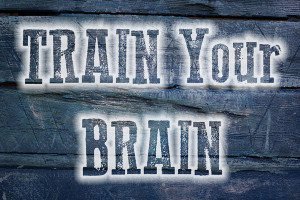
For optimal results you would gradually add to your total, a few pounds at a time, to constantly challenge yourself.
The same idea applies to building on the knowledge you already have.
If you’re no longer challenged using an addition and subtraction pattern try addition and multiplication.
If the alphabet backwards is no longer a challenge, try recitation in English and another language, switching with each letter in succession.
Try larger numbers for your mental rotation.
Use historical dates (birthdates or inauguration dates of Presidents, publish dates of pieces by your favorite composers, etc.). These larger, four-digit numbers are a challenge to build upon.
Go beyond the elementary school basics and create a real-world gymnasium for even more of a challenge.
Instead of suffering through a mindless morning commute, use your drive into work to memorize license plates.
Use these random sequences of letters and numbers as a jumping off point for the alphabet and summation exercises we just discussed.
3. How To Increase Mental Fitness By
Using Popular Culture In Your Brain Games
Even sources of entertainment can be used as brain exercise.
Take a favorite actor or director and see if you can list their filmography either in historical order or reverse historical order.
Then take it a step further:
See if you can list all the actors in your favorite film.
You’ll easily create connections, or a web of sorts, of actors, directors, and movies. From a casual observer to a movie buff, this “celebrity cultivation” exercise is a great activity for any level.
4. Powerful Brain Games With Language For More Exciting Challenges
Building upon the alphabet to increase the level of challenge, try suppression or skipping.
For example, think of A, skip B, think about C, skip D forwards, then go backwards, with Z, skip Y, X, skip W, and so on. The patterns for skipping around are endless just for the alphabet.
Move on to whole words next.
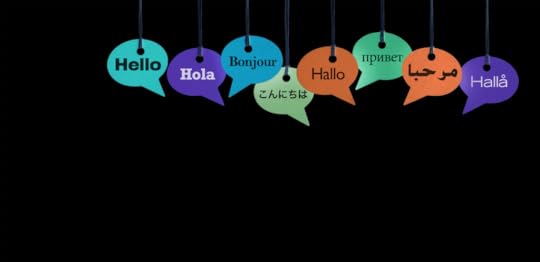
If you don’t want to work with the language you’re learning, take your list of celebrities you cultivated earlier.
Instead of simply naming Angelina Jolie as a favorite actress try spelling her name with suppression. A, skip N, G skip E, and do the opposite for her last name:
Skip J, O, skip L, etc.
You can use this method for a database of historical figures if history is your concentration, medical terms, elements of the periodic table, or even just to memorize the names of your colleagues at a new job.
5. Brain Games with Foods That Improve Memory
Ask any fitness expert and they will agree that exercise alone is not going to cut it if one is trying to shed extra pounds.
There is a golden rule that weight loss is approximately 20 percent exercise and a whopping 80 percent diet. Weight loss happens with a caloric deficit, meaning more calories are burned than consumed. Basically food is the key element to healthy living.
 Diet and exercise work as a team to achieve overall health, so naturally brain games involving food are a great way to work out your mind. These games might even be better than vitamins for memory improvement you’ve heard about on advertisements.
Diet and exercise work as a team to achieve overall health, so naturally brain games involving food are a great way to work out your mind. These games might even be better than vitamins for memory improvement you’ve heard about on advertisements.
So the next time you head out to the grocery store, add these mental exercises to the physical fitness you’ll be getting while on the road.
Memorize the ingredients to a favorite recipe, equivalencies in baking (3 teaspoons are equal to a tablespoon), or try to imagine the result of a flawed recipe by using suppression or skipping to purposefully overlook an ingredient.
Imagine omitting baking powder from a pancake recipe or eggs from a cake. Visualize the results.
Then, take the healthy approach and try “brain active” foods.
Mentally calculate the amount of baby carrots you could eat to equal a serving of Ben & Jerry’s Ice Cream, or the cups of baby spinach to amount to the calories in a serving of New York style cheesecake.
6. Get Your Mouth Into The Physical Exercise For Brain Boosts
Make a game of memorizing your shopping list in another language. Even pig latin will do.
Or if you must do it in your mother tongue, try this instead of rote learning the list:
Commit to memory that you need milk, eggs, and bread, by reversing the letters of each word. Recite that you need K-L-I-M, S-G-G-E, and D-A-E-R-B.
After spelling and pronouncing your list backward, practice the same list using the skipping/suppression exercise to spell your items.
7. Physical Brain Exercises That Improve Concentration
I learned the metronome exercise from Matthew Clark at York University. It is a great exercise to improve concentration with minimal equipment.

By using either a physical metronome or any of the widely available apps for smartphones try to synchronize your claps or snaps with the beat, then gradually slow the beat down, increasing the distance between claps or snaps.
By mixing both a mental exercise with a physical action this will increase your concentration over time. For an even greater challenge, once you’ve mastered this, try the same exercise with your eyes closed.
8. The Four Details Exercise
If you want to incorporate elements outside yourself, try the four details game I learned from memory expert Dr. Gary Small. When you are introduced to someone new try to memorize four details about them.
This could be their eye color, what color shirt they were wearing, or hair color. When you recall their name, recall these details.
You can add even more of a challenge to this passive exercise (simply noticing details about someone) by making these details magnetic.
For example, if your new acquaintance has a red jacket, you can associate a mnemonic, magnetic image to that red jacket.
Or, if your Magnetic image of red is an apple, you can associate Amy’s red jacket to apples.
Finally, build upon the celebrity list you learned about earlier.
Take one of the films you named and try to recall the movie’s plot points in order. How many times have you tried to tell a friend about a great movie you watched the weekend before, only to find that a lot of the details were fuzzy.
You could remember the beginning that pulled you in and grabbed your attention and the action packed finale that left you clamoring for a sequel, but everything in the middle wasn’t so clear.
Instead of shutting your brain off the next time you turn on Netflix, try, instead, to keep yourself engaged so that you can recall the entire film. It’s a great way to satisfy the need for entertainment while giving your brain a workout.
9. Yoga For Mental Sharpness:
The Ultimate Physical Brain Exercise
Incorporating a physical practice, just like the metronome exercise is a fantastic way to increase the power of your memory.
If you already have a practice in place, you can use as few as three poses and flow between the movements, using your flow to rehearse memorized content.
If you are new to yoga you can learn a few simple, beginner poses followed by an easy way to shift between them.
After finding what works for your body, balance, and skill level, combine the sequence of movements with reciting information that you have committed to memory.
To build on this idea, if you want to take your yoga practice off the mat, or if you find yourself frustrated with your physical yoga practice, you can shift into the more mental practice of karma yoga.
The purpose of this practice is to humble your ego, serve your community, and causes you to become part of something bigger.
You are acting selflessly in service to others, doing good things for others with no expectation of anything in return.
You are putting a selfless action out into the world with no expectation of return. Letting go of the outcome, by sampling taking action because it is the right thing to do.
10. Why Karma Yoga Is The Ultimate Brain Exercise
How does this kind of yoga count as brain exercise?
The answer is simple:
You are constantly reminding yourself, keeping yourself in check, that once you have set an action out into the world it is no longer yours to control.
This consistent reminder to one’s self, in itself, is an exercise in staying present, building concentration through self-awareness.
Think back to your childhood.
If you were anything like me you loved Super Mario.

Was there that one level that you just couldn’t seem to get past? Whether it was being eaten by a piranha plant or missing a jump, you would get frustrated if you ever got stuck, right? It’s a natural reaction…but it doesn’t have to be that way.
A great mental exercise would be to revisit those sometimes tantrum-inducing games as adults. What if you could play simply for the sake of enjoyment?
What if you could laugh off constant defeat by the goombas a koopa troopas and just have fun? What’s stopping you from finding joy just in the action of play? Absolutely nothing but your own mind.
You can enjoy the journey, powering your way through the levels, with a karma yoga mindset, letting go of the expectation of saving Princess Peach, and simply playing the game.
Over time, you’ll find with the act of letting go the levels pass easier, because your practice will be enjoyable and your skills will then improve.
With reevaluation and consistent review of your mindset to one of karma yoga practice, concentration is less forced, and thereby memory improved, because your focus is shifted.
Karma yoga concentrates the mind, crumbles bad memories, makes life a bright and shiny game, and creates a wonderful treasure-trove of memories, all through a shift in mindset.
11. The Brain Game of Bhakti Yoga
To take mental yoga even further, another branch of yoga, bhakti yoga, is a practice of “love for love’s sake,” or “union through love and devotion.”
Simply put, bhakti yoga is a practice of devotion, in its broadest sense.
This word can be interpreted in many ways, with the idea of devotion being such a general term, but it goes effortlessly hand-in-hand with memory palaces.
By physically visiting inspiration for memory palaces, such as a childhood home (even if yours was a turbulent one), practicing forgiveness in order to build a memory palace from a place that perhaps heartbreak resided is a powerful manifestation of bhakti yoga.
Committing to a life of love, with receiving nothing in return – incorporating the karma yoga ideals is a mental exercise, again, to constantly evaluate your thoughts, and therefore shapes your actions.
You can also turn this practice inward, through devotion towards self-inquiry.

We must all constantly look inward, examining our own thoughts in order to have a mindset of karma, or mindset of love.
Instead of passively having thoughts, or being passive, letting those thoughts control us, we must constantly examine our thoughts, asking ourselves:
“How do my thoughts behave?”
“Are they useful?”
“Just how real are my thoughts?”
For more information on questions like these, please read Evolving Beyond Thought by Gary Weber. It is excellent and the source of these questions.
With this devotion to self, a devotion to the health of our own thoughts, developing a concentration, an active mental state this will prime our brains for memory growth.

And like many of the other exercises, you can perform these self-inquiry questions while on a walking meditation.
12. Magnetic Dream Recall as Brain Exercise
Finally, training does not have to be limited to our waking hours. With a few simple techniques all 24 hours of our day can be productive, and we can exercise our brains in a dream state.
First start with the concept of lucid dreaming. In order to utilize your dream state, you must realize you are, in fact, dreaming.
A practical way to know if you are dreaming or awake is to draw a symbol on your hand (a star, heart, smiley face, etc.) with a permanent marker. You will know that you are awake if you look down and see your symbol. If it isn’t on your hand, it is likely you are asleep.
By knowing you are in dream state, you can sort through alternate realities you perhaps have created for yourself, or are punishing yourself for.
You can separate fantasy from reality, and understand what a healthy reality is subconsciously, so that your waking life is no longer filled with suffering-inducing expectations caused by a dream state.
Practically, you will also be able to practice your autobiographic, episodic, and figural memory. If you incorporate dream journaling and autobiographical (the events of your day) journaling into a daily mindfulness practice you will be able to not only remember more of your dreams, but remember more of your waking life. Over time your memory will improve by focusing on its improvement, setting a goal of improving it.
Final Thoughts On Keeping Your Brain Well Exercised And Your First Steps
All of these techniques are beneficial to memory improvement, and will improve your concentration through disciplined practice, incorporating neurobics into your everyday life, however, you cannot improve if you don’t know where to start.
If you have no idea of where you are with your memory health, you cannot take the steps to make it better.
Join me now to begin the journey of self-awareness and the first step to better brain health.
The post 12 Brain Exercises To Improve Memory (Step-By-Step Tutorial) appeared first on Magnetic Memory Method - How to Memorize With A Memory Palace.
November 21, 2018
How To Learn Faster With The AFT Learning Model
 If you’ve been trying to learn faster and keep getting stuck, chances are you haven’t got the AFT Learning Model on your side.
If you’ve been trying to learn faster and keep getting stuck, chances are you haven’t got the AFT Learning Model on your side.
And if you’re someone who invests in coaching so you can reach your learning goals and they’re not aware of how learners need Action, Feedback and Triggers, then you need to reconsider the person you’ve got on your side.
To clarify just why the AFT Learning Model (Action, Feedback, Trigger) is so important to learning, Edan Kertis of MyQuest joins me on this episode of the Magnetic Memory Method Podcast.
Success is something we understand very well at a neuro chemical level.
The questions is…
How will our educators use the best 21st century technology has to offer to magnify their ability to coach us toward results?
And is it even possible?
Can Coaching Apps Really Help You Learn Faster?
As a memory blogger, vlogger and podcaster, I truly believe that it is possible to learn faster and remember more using the kind of software Edan has created.
And there is a long track record of seeking insight into the matter…
I’ve posed similar questions to Gabriel Wyner, creator of the Fluent Forever app.
Olly Richards and I have also discussed the ins-and-outs of this topic when it comes to getting the most out of online language learning courses.
I’ve talked about mnemonics and language learning in “virtual Memory Palaces” with Timothy Moser.
I hope to get Jaron Lanier on the Magnetic Memory Method Podcast to talk about Dawn of the New Everything and his views on VR as a kind of Memory Palace.
And the reality is…
I keep my mind open, but…
Not so open that my brain falls out.
Why?
Because the threat of Digital Amnesia is real.
Worse…
Some people are taking related technologies into some pretty dark territory.
Then there’s Neuralink.
Don’t think it can’t happen.
And before you open your skull to receive, understand that there are at least 7 Reasons Having A Memory Implant Would Really Suck.
Yes, the technology really can grow so small that our coaches start crawling into our heads.
The Future Of The Magnetic Memory Method App…
Despite my concerns over these technologies, I’m still open to designing a Magnetic Memory Method app.
In fact, a wireframe for a very good “passive training app” already exists.
This app is probably best used in hospitals for helping stroke and brain trauma victims recover their memory abilities. But it could help every day people remember more and learn faster too.
It’s pretty clear that MyQuest could help create a “guided” version of the Magnetic Memory Method Masterclass.
We shall see what the future brings as I continue to explore the discussion Edan and I started a few years back in Tel Aviv.
In fact, Edan introduced me to Hummus Mshawsha, one of the city’s best kept secrets. It’s also become one of my favorite Memory Palaces.

I’m very honored to have an ongoing discussion like ours with such an accomplished entrepreneur and technological innovator.
If you haven’t heard our previous discussion about the role of questing in your education, you’ll learn a lot from Edan. And you can fill out our survey about the MMM app yet to come on that page.
How Fast Do You Want To Learn?
At the end of the day, today’s episode of the podcast will help you discover the AFT Learning Model so you can make better education choices.
It will always be based on your learning style.
Whether you’re into using Stoic Secrets For Using Memory Techniques With Language Learning or…
You want to reach your memory improvement goals with “Atomic Habits”…
This discussion will put you in good stead.
Let us know in the discussion below just how the ability to learn at a faster speed would improve your life – and what you’ll do when you can.
That’s your call to action.
You’ll get feedback when you post.
And I promise I’ll say something that triggers further action to keep the right kinds of action flowing towards the right kinds of feedback and triggers in your learning journey.
Sound like a deal?
The post How To Learn Faster With The AFT Learning Model appeared first on Magnetic Memory Method - How to Memorize With A Memory Palace.
November 15, 2018
Next Level Memory Training Secrets with USA Memory Champ John Graham
 Want memory training secrets from a bona fide memory champion?
Want memory training secrets from a bona fide memory champion?
You’re in the right place.
And even better than talking about mnemonic examples, Memory Palaces and general mnemonics…
When you click play on the recording above…
John Graham, the 2018 USA Memory Champion shares the mindset, strategies and habits needed to train your memory…
Under pressure.
And the ability to perform under pressure matters for everyone, whether you’re recalling information on TV…
Names at a meeting…
Or information during an exam at school.
Why I’m So Impressed With John’s Memory Training Know-how
As a memory enthusiast and blogger specializing in memory techniques, John’s skills and the information he offers through his memoryjohn website and email newsletter are top notch.
And as you’ll hear today…
John originally didn’t think he could use memory techniques!
He went on an incredible journey to find courage, consistency and competence with memory training.
The same levels of laser-sharp mental clarity you can find too…
Just by listening to the right memory training mentors.
Why You Need To Train Your Memory For The Long Term
And John is indeed one of the best because he helps you see both the short and the long term benefits of memory training…
All while making sure that you find ways to stay with it for the long term.
Why does that matter?
Because life’s rewards go straight into your memory… nowhere else.
Think about it:
Cars… houses… money…
They all change, get lost, lose value.
But memory?
The more you can hold onto, the greater its value increases the longer you can call it your own.
And if you can’t remember the great things you learn, then you risk losing life’s treasures forever.
So follow John’s lead and overcome whatever mental rubbish might be holding you back from success with memory techniques by following his lead.
And if you want to see John working his memory magic with your own eyes, just click play on this incredible video:
Then, as you’re listening, make sure you follow John on Twitter.
The Next Level Memory Ideas I Enjoyed Learning The Most
Personally, I benefitted the most from hearing John talk about:
Crafting the mindset needed to develop memory competitor-level skills
Deliberately using additional difficulty to increase your memory chops quickly
The correct use of memory training apps and software to avoid falling into the traps Digital Amnesia
How to incorporate consistent training into a busy travel schedule
All of these points will help you in your memory practice just as they helped me.
Even better:
After listening, you can leave us a comment below with your questions and comments so you too can experience “next level” memory skills!
Further Free Memory Training Resources
How to Win the USA Memory Championship
8 Reasons You Need A Flexible Memory Method Not A Memory System
5 Note Taking Techniques That Force You To Remember More
The post Next Level Memory Training Secrets with USA Memory Champ John Graham appeared first on Magnetic Memory Method - How to Memorize With A Memory Palace.
November 7, 2018
Brain Games, Sommelier Studies And Avoiding The Oliver Cromwell Effect With Christian Fitzharris
 What kind of brain games do you think will help you focus better and remember more?
What kind of brain games do you think will help you focus better and remember more?
If you’re like most people, you’re probably searching for an app.
Well, not Christian Fitzharris.
Actor, musician, sommelier and author, Christian plays brain games with words.
And to make the brain exercise even more effective, he adds juggling to the mix too.
In fact, I was so blown away when I saw a video of Christian playing an authentic brain game, I could help but record a response!
For the original video that started it all, check out:
Then click play on the interview above and discover:
How Christian first encountered memory techniques and mnemonics.
The differences between different kinds of acting.
The role of memory techniques in becoming a sommelier.
The role of using mnemonics while imbibing alcohol in a professional role.
How to avoid the “Oliver Cromwell Effect” when learning to use mnemonics.
This final point will be especially important for those who want to become a living mnemonics dictionary.
The alternative?
Getting endlessly lost the constant hunt for mnemonic examples and be trapped in learned helplessness forever.
The ultimate cure? Play Brain Games as Christian suggests. In case you want to follow along with his rap, here are the wonderful lyrics he created…
“Brain Games”
BY SCHOLAR & Anthony Metivier
“I Define Establish
Exercise and Practice
Externalize Spatial maps
As I attack the path of, “mature learner”.
“Bottle Burner”
But I yearn to max memory reserve
In earnest/
I’m a furnace.
An anomaly.
Sibling of Simonides, known.
To Reduce Cognitive load.
And oh-
How I ro-tate
Juggle-ing space
Makin’ a case
For Brain Games so Digital Amnesia
Leaves ya.
Digital dementia is censored.
Did ya all tag Herrenium on your mind wall?
Re-view recall? (We will evolve!)
Chorus:
Brain Games synapses flashin’
Mind Palace crashin’
With the Brain Games
Info encoded, mental high roller.
Brain Games, don’t need an app for that
I just attack with the path of a lab rat.
I mean, scientist.
I’m an annihilist finalist
Illuminist mneumonist
Doin’ this, provin this.
Who is this? SCHOLAR!
Dopamine fiend
Clean sheen like the Pleaides.
Enemies, ill at ease.
Killin’ with abilities.
Strollin’ with affinity.
Rollin’ with my Kennedy’s.
Brain Games-
Healthy snacks!
Build a palace.
Peg some facts.
Learn to Balance
While you rap!
Unleash talents, don’t look back!
For More On Christian Fitzharris…
Christian is a man of many talents. Connect with him on:
Further Resources
For more ideas on how to keep your brain fit, check out these 5 Brain Exercises That Ensure Memory Improvement.
The post Brain Games, Sommelier Studies And Avoiding The Oliver Cromwell Effect With Christian Fitzharris appeared first on Magnetic Memory Method - How to Memorize With A Memory Palace.
October 30, 2018
How To Practice Memory Techniques For Studying Tough Subjects
 You know success with memory techniques for studying requires practice, right?
You know success with memory techniques for studying requires practice, right?
That’s a no brainer. But here’s the catch that stops many people cold in their tracks:
Because people also know adding another skill will require time…
Getting started with memory improvement kind of freaks them out!
But what if there was a way for memory techniques to save you time instead of costing you time?
One that lets you cut like a laser through even the toughest subjects and most challenging languages?
And in a way that creates more energy instead of making you feel burned out all the time?
In this post, I’ll share with you exactly how you can make that happen.
But first, please understand this:
My Memory Techniques For Students Started With A HUGE Dream
Let me ask you something:
When you were a child what did you want to be when you grew up?
An astronaut, firefighter, veterinarian, princess, or cowboy?
Perhaps it was something more … heroic.
Me?
Well, long before I wanted to be an author and a professor…
I wanted to be Batman.

Yes, the caped crusader and defender of Gotham himself, Batman.
Of course, I eventually grew up.
As we grow older, our ambitions change and we tend to choose professions that are more practical.
Or we select careers that will make us financially secure, which is usually not the same thing as following those childhood dreams.
But because I learned how to integrate memory techniques into my every day life through proper practice with them, I actually did follow my childhood dream and grew up to be something like a “Mnemonic Batman.”
Why The Right Memory Techniques Will Make You A Real Life Superhero
Wait a minute!
How is that possible?
After all, I’m certainly not the billionaire playboy, Bruce Wayne.
But that doesn’t matter.
You see, the thing that makes Batman, Batman is not superhuman strength, intelligence, or any number the of supernatural powers possessed by our favorite comic book heroes.
It’s practice.
And for anyone who knows the full Batman story, anyone who practices the right things can wear the Batman mask for a few simple reasons:
1) Batman is a trained scientist who practices science
2) Batman creates the tools he needs to get the job done (and practices creating them)
3) Batman trains with the tools needed to get the job done (including training his body, which is also a key part of memory improvement along with eating foods that improve memory)
Other than that, Batman is just a normal guy with a utility belt loaded with knowledge and tools earned through practice.
The Most Important Memory Improvement Tool Of All
I’ve equipped my tool belt over the years with many memory techniques.
But at the end the day, the most important tool of all is discipline.
Is discipline itself a memory technique?
Yes. When you train yourself to remember to practice, your ability to implement becomes stronger.
Your ability to experiment (like a Batman-level scientist) with new memory techniques also becomes stronger. You learn to have courage through disciplined practice.
And you understand that all memory training you undertake is worth the time you risk because memory practice causes you to stretch and grow.
The best part is that you already possess two things:
1) A vast ability to develop the discipline of practice with memory techniques
2) A massive depository of mental imagery in your episodic memory to practice with
But at this point, you may be wondering…
What Are The Right Memory Techniques For Studying Tough Topics And Complex Languages?
The answer is…
It depends.
We’ll talk more about the options, in this post, but for now, here’s a roundup of the best:
The Memory Palace is foundational across the board. You need to know this technique because every other technique can be used inside of a Memory Palace.
Some people call this technique the Method of Loci, but I think that term is flawed. To learn more about why, check this out:
The important thing to understand with the Memory Palace is that they work best in a network.
That’s what allows you to expand your spatial memory and get the most use from your Magnetic Bridging Figures.
You may also need the Major System (a.k.a the Major Method).
But you might not need it right now, so it’s fine to save it for later.
Next, you need Recall Rehearsal. This process is what lets you load the information you memorize into long term memory.
But These Three Major Memory Techniques Sound Like A Lot Of Effort!
Yes, and no.
Please don’t let yourself get overwhelmed.
If anything, you should consider overwhelming yourself on purpose, if only for a short while.
How?
Dive in and practice what my friend Jonathan Levi calls “brute force learning.”
That means instead of trying to cover every last detail, you rush in and get the broadest possible overview as quickly as possible.
Only after that has been accomplished, do you zero in on the fine details.

And only then can you discover what memory techniques are really all about without getting caught up in the Sherlock Holmes mythology that traps many students who wish they could use memory techniques as well as they want.
The point is:
You need to bring a sense of adventure and a sense of play.
That will make learning and practicing memory techniques easier and more fun.
To help you discover this sense of fun and adventure…
Think Back … (A Quick Memory and Brain Exercise)
Think back again to your childhood. Whether you begrudgingly took piano lessons, played Little League baseball, or had a starring role in the school play, the one key to your success was practice.
With practice you could play scales from memory, throw a faster pitch, or recite your lines flawlessly (while your peers still had their noses in their scripts).
If this idea worked for us as children, why have we abandoned it as adults? Its importance is clearly evident, especially in the world of memory improvement.
Take the professional musician. Practice is something that is a part of their everyday lives, especially “dedicated practice.”

Musicians learn and repeatedly perform physical actions. The play the notes on written sheet music or their own composition with “specific sounds and visual patterns (musical notation) while receiving continuous multi-sensory feedback.”
It is believed this “association learning” or training of the neural network can lead to brain plasticity, actually changing the structure of the brain,
In short, with practice, the brain’s ability to modify itself (i.e. rewire its connections) over time is strengthened.
You may ask “Why is that important? Why would my brain need to change if it is the control center of my body? Isn’t it kind of static?”
Your Brain Has An Extraordinary Knack For Learning Memory Techniques
It’s just practicing using them where most people fail.
Now, you might not feel that they are easy in the beginning, but your brain is actually perfectly suited to learn memory improvement tips and tricks.
And the only reason why people struggle in the beginning is because they haven’t used their memory muscles in quite this way before.
But once they get started, a very exciting fact kicks in that isn’t just for musicians:
Every Brain Has The Ability To Modify Itself Through Practice!
Not only during childhood (when the majority of formal learning takes place), but especially during adulthood, perhaps even most crucially in one’s senior years.
You know what that means, right?
It means you’re never too old to get started!
And your brain adapts so readily to training.
Think about it:
With everything from recovery from injury, alleviating chronic pain, to enabling easier use of prosthetic devices.
Your brain can even adapt to artificial hearing devices. Neuroplasticity is not to be taken for granted!
All your brain needs is care, cultivation, and training through extended practice.
Using Memory Techniques Is Creative Repetition, Not Rote Learning
When training your memory, practice is more than just repetition.
Most repetition is boring and painful, after all, and so it’s no wonder so many of us easily dismissed it in our everyday lives.

Yet, in the beginning, practicing by memorizing cards or setting up your first P.A.O. with something like Florian Dellé’s Major System may make you think:
“But isn’t this practice with the techniques just doing something over and over?”
Stop.
Thoughts like that instantly take you back to those hours behind a piano, or reciting lines from your third grade play script until they were committed to memory when you would have rather been playing video games or splashing in a mud puddle after a good rainstorm.
But practicing with memory techniques is not like that at all, once you get used to them.
An Unusual Source of Inspiration For Practicing Memory Techniques For Your Studies
Right now, I’m studying a lot of Sanskrit for a large learning project about Advaita Vedanta.
In his book, Happiness Beyond Thought, author Gary Weber explores this idea of the importance of practice, serving as a practical guide to awakening.
Gary Weber might not be a memory expert, but he’s memorized a ton of Sanskrit and has some skills. Recently, I’ve been following suit by memorizing his selections from the Ribhu Gita:
Back to Happiness Beyond Thought and what it teaches us about practice:
Basically, the book is about bringing yourself to a state where you are no longer troubled by worry, concern, or thoughts that impeded your conscious state.
Even better:
You essentially escape the traps of the ego, of the self, and you experience this wonderful state of “happiness beyond thought.” I’ve certainly been having a good taste of it.
Now, “happiness is a complicated word.” I often think of eudaimonia which is ancient Greek for happiness, though it is said to be better translated by experts as meaning “flourishing.”
But then, you might be thinking … How can having a still mind be flourishing?
Especially when you’re filling it with Memory Palaces and Magnetic Imagery!
I know, I know. It does seem contradictory.
How Memory Practice Positively Changes The Structure Of Your Brain
But here’s the thing:
As we’ve just discussed, neuroplasticity shows that the brain can change.
And when you’re training to memorize information that is good for your brain, your brain cannot help but change in positive ways.
The more you practice, the more you create flow and a level of ease that can come only as a result of practice.
From this state you will develop a stillness. An inner peace.
But only if you show up and put in the work can the discipline of practice grow and fortify those neural pathways and strengthen existing connections in your brain.
Why Smart Phones Are Destroying Your Ability To Practice Memory Techniques
In this age of smartphone addiction where we essentially have a computer in our pocket, long division is a thing that seems straight out of the Stone Age.

But again, think back to when you were learning long division in elementary school.
Do you remember how frustrated you were with the first couple problems you tried? Your little pencil eraser probably got quite a workout!
But, with practice, how were those same problems by the end of the year? You could fly through them with ease, without a second thought. You developed those connections and were able to solve 936 divided by 2 almost automatically.
And if you had to learn it all over again, those rules of math are still true. You would just need to put the cell phone aside for long enough to learn how to make the calculations again either on paper or in your mind.
This is why I teach people about Digital Amnesia and the importance of “digital fasting.” If you don’t take time away from the devices to exercise your memory, you will lose the ability to use it altogether.
How To Choose Your Memory Improvement Habits Wisely
So how does one develop good practice habits to help us in memory practice? First, start small. Not to say you don’t want to “dream big,” but think about your goals. Really think about them.
You can have different kinds of goals.
You can have very big, huge, hairy, snarly, real over the top goals, where you must build a long-term path to achieve that goal, or smaller goals, for the more short term.
James Clear says in his book, Atomic Habits, “If you choose a habit that’s very small and it accumulates with a bunch of other small changes to form a larger system then you can end up with a very remarkable result, or an immensely powerful outcome.”
And so the practices that you will do need to have some focus on what it is you want to achieve
How To Make A Practice Plan For Using Memory Techniques In Your Studies
Create a “Memory Journal.”
Personalize your Memory Journal so that you feel more connected with it (draw on the cover, add stickers, etc.)
Set a specific and measurable learning goal.
Use this Memory Journal to gather together the floor plans of your Memory Palace Network.
Use the Memory Journal to describe your Magnetic Imagery and guide the encoding process.
Yes, this is a manual activity, but it will actually speed up the process of learning how to practice.
When you personalize your Memory Journal, it will not only have more meaning, but visually stand out from other books in your learning space.
If you’re already an intermediate or advanced memorizers you can squeeze small Memory Palace drawings into The Freedom Journal, which I highly recommend.
Practice The Kind Of Memorizing Based On Your Desired Outcome
If it’s speed, if it’s length of retention, if it’s volume of information or if it’s a combination of all those things, then a combination of all those things for what, specifically?
Is it for memorizing playing cards? Is it for foreign language vocabulary? What is it for?
These questions really matter!
Next, build the practice routines that will help you achieve those outcomes and those goals.
More importantly, pick the right techniques that are going to get there.
Why Is The Memory Palace Always The Right Technique?
In a word, it’s because all memory techniques are spatial in nature.
To take just one example of a relatively week mnemonic technique:
If you are using acronyms, each letter exists in relation to the next (either to the left or right of the preceding letter).
And since all information is laid out in a linear and temporal order, you might as well start with the foundational technique. Master the Memory Palace, and then use all the other memory techniques inside of Memory Palaces to harness the power of sequentialization.
And to do this well, to tailor your practice with making information linear so you can memorize it, you must have a plan.
“A goal without a plan is just a wish” – Atoine de Saint-Exupery
Whether you’re a culinary wizard or a novice baker who struggles to make box brownies for their child’s school bake sale fundraiser, one thing you know if you’ve ever been in a kitchen (and who can live on take-out alone these days, right?) is you must have a plan.
Think about it:
You cannot go into the kitchen to make beef bourguignon with only 30 minutes to get dinner on the table, and you wouldn’t dream of trying to craft the perfect macaron without eggs or sugar.
You must have a plan…or in the culinary world, a recipe to achieve your end result, and a good plan takes organization. Kind of like my wife and I had a plan when we made these memory-friendly pancakes:
This level of organization is what we teach in the Magnetic Memory Method, to organize your mind with a Memory Palace, so that when you sit down to memorize you can do it in an organized manner.
Remember the musicians we talked about earlier?
They wouldn’t simply sit down behind a music stand with a piece out of order and attempt to play it.
No, in order to practice effectively, to make the most of their time, they would make sure their sheet music was in the right order.
They would make sure they were warmed up properly, and their instrument was at its peak playability (i.e. they were in tune, all valves were clear, and they had a fresh reed or strings, given their instrument of choice).
Your Next Step With Memory Techniques For Studying Well
In a word, you need commitment.
There are more components to practice than simply setting a goal and getting organized. There is the greatest element of practice of all:
Your habits.
This is where the idea of improvement comes into play, and the idea of flow that we discussed up above.
In order to improve, to achieve that state of stillness, of awakening, and of peace as skillful individuals, we must show up and put in the work, consistently.
Yes, you must be committed to mastering your habit to see results. In that way our outcomes are linked to practice and our practice to our outcomes.
Again, the greatest thing we can do to achieve our goals is show up, and show up consistently.
For example, every morning before my wife wakes up I practice my memory training. Today my goal after working some Sanskrit into memory was to memorize a selection from a deck of cards.
As I mentioned the morning I recorded this live stream, I got through memorizing only four cards:
Granted, that’s a low number for me in my practice, but my time was limited.
Even so, l made the time to practice. I exercised the discipline needed to sharpen my skills, and you can do the same, even if it amounts to only minutes a day.
But I “Can’t…” The Ultimate Memory Training Excuse And How To Eliminate It
You may feel like you don’t have the time, the energy, or the willpower…
You might be frustrated because you feel like your memory work has stalled.
You may be comparing yourself to those that have achieved the goals you aspire to, or who simply seem to “get it” more easily.

Stop. Just stop and breathe.
And then consider learning to mind map and explore how you can commit to practicing to improve your memory for large learning goals.
Finding commitment is important because the most empowering key to Gary Weber’s idea of practice is finding resources inside yourself.
Weber writes:
“Insisting that you follow precisely the path that worked for your teacher is guaranteed to be inadequate in some way. Any student, no matter how diligent and well-prepared, is going to be different from the teacher in conditioning, experience, age, genetics, family history, bodily and mental capability, etc. How could something as complex and comprehensive as awakening not be a personally tailored process?”
That’s a solid point, and it’s why I’ve always talked about the Magnetic Memory Method as a “method,” not a system, because I already know this truth:
You cannot simply adopt someone else’s system. Rather, you need to create your own, because everyone’s needs are different. My goals are not your goals. My learning style is not your style.
Notice also the word “precisely” in this quote from Gary Weber.
Weber doesn’t mean that you don’t follow the path of your teacher at all.
Instead, you must avoid the fantasy, the hoping, wishing, and praying, that anything will play out exactly as it did for your teacher.
To try and recreate anything “precisely” is the trap of expectation. And expectation always leads to suffering.
But rest assured that you really can follow in the footsteps of teachers.
Gary Weber talks about how he has done this himself and there’s truth to that old phrase about standing on the shoulders of giants, which is even older than Isaac Newton. In many cases, it’s the only way we get to see beyond ourselves.
And using the teachings of Giordano Bruno and many others as my own guide, please use the Magnetic Memory Method as it was intended to be.
It is a technique, a tool in your utility belt, a method of practice to reach your memory goals. And as someone who used them to earn my Ph.D., I crafted the approach I now share with thousands of people around the world with studying in mind.
With practice, you can achieve any learning goal. Along the way, you can also achieve the inner stillness that comes with mastery or your mind and memory.
It just takes practice, discipline and the right teacher.
Get all that together and you too can be a “Mnemonic Batman.”
The post How To Practice Memory Techniques For Studying Tough Subjects appeared first on Magnetic Memory Method - How to Memorize With A Memory Palace.




